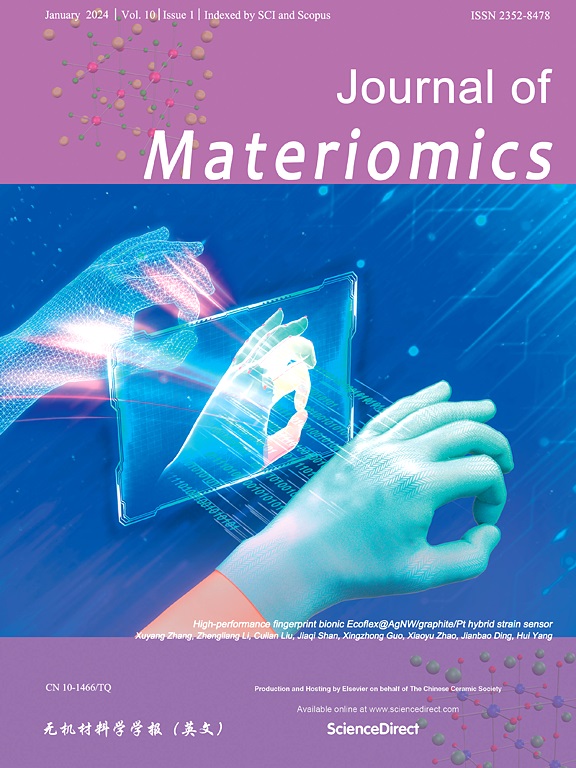Site preference of Ni in Pb(Fe1/2Nb1/2)O3 during additive compositional modification
IF 8.4
1区 材料科学
Q1 CHEMISTRY, PHYSICAL
引用次数: 0
Abstract
Doping and substitution methods are predominantly employed in the synthesis of ceramics to achieve their desired functional properties. We studied the behavior of excessive dopants in addition to an existing stoichiometric composition using a high-throughput continuous compositional spread sputtering method. We paid attention to the possible formation of thermodynamically unstable phases by the addition of an excessive amount of dopants. We showed that even when dopants were added as an additive, they dissolved into the existing lattice due to the benefit of the entropy of mixing. Regardless of excessiveness, all added elements incorporated into the lattice, stabilized by the tolerance factor. We also demonstrated our findings exemplarily with lead iron niobate to induce magnetic properties alongside inherent ferroelectricity (MS = 10 emu/cm3, PS = 16 μC/cm2). We compare the results from CCS with those from the non-additive solid-state method, leading to a conclusion that the benefit from the entropy of mixing allows foreign elements to substitute for the elements initially residing in the lattice to a degree in compliance with the Goldschmidt tolerance factor. This observation was confirmed by a density functional theory calculation. We anticipate that our study could necessitate intensive research on achieving desired composition through industry-friendly processing.

添加剂成分改性过程中 Pb(Fe1/2Nb1/2)O3 中 Ni 的位点偏好
陶瓷的合成主要采用掺杂和替代方法,以获得所需的功能特性。我们采用高通量连续成分扩散溅射法,研究了在现有化学成分之外添加过量掺杂剂的行为。我们关注了添加过量掺杂剂可能形成的热力学不稳定相。我们的研究表明,即使掺杂剂作为添加剂加入,它们也会因混合熵的作用而溶解到现有晶格中。无论过量与否,所有添加元素都会融入晶格,并通过容差因子稳定下来。我们还以铌酸铅铁为例演示了我们的研究成果,在诱导固有铁电性的同时还诱导了磁性(MS = 10 emu/cm3,PS = 16 μC/cm2)。我们将 CCS 的结果与非相加固态法的结果进行了比较,得出的结论是:混合熵的好处是允许外来元素在一定程度上替代最初存在于晶格中的元素,这与戈德施密特公差系数相符。密度泛函理论计算证实了这一观察结果。我们预计,通过我们的研究,有必要深入研究如何通过工业友好型加工实现理想的成分。
本文章由计算机程序翻译,如有差异,请以英文原文为准。
求助全文
约1分钟内获得全文
求助全文
来源期刊

Journal of Materiomics
Materials Science-Metals and Alloys
CiteScore
14.30
自引率
6.40%
发文量
331
审稿时长
37 days
期刊介绍:
The Journal of Materiomics is a peer-reviewed open-access journal that aims to serve as a forum for the continuous dissemination of research within the field of materials science. It particularly emphasizes systematic studies on the relationships between composition, processing, structure, property, and performance of advanced materials. The journal is supported by the Chinese Ceramic Society and is indexed in SCIE and Scopus. It is commonly referred to as J Materiomics.
 求助内容:
求助内容: 应助结果提醒方式:
应助结果提醒方式:


